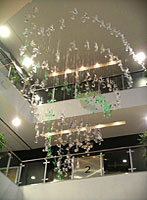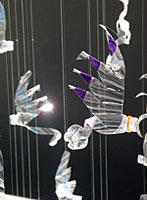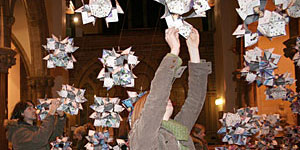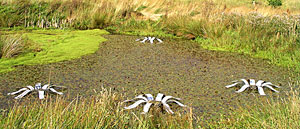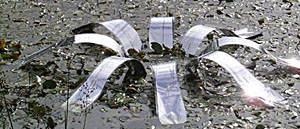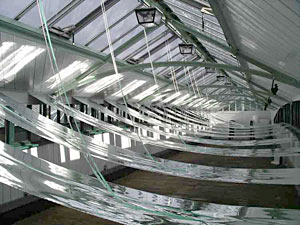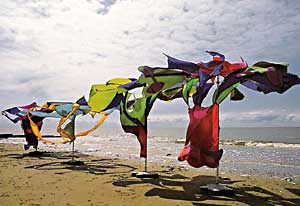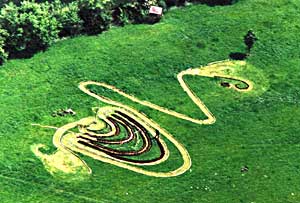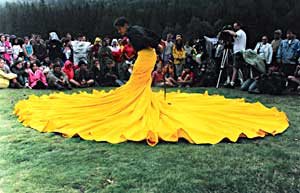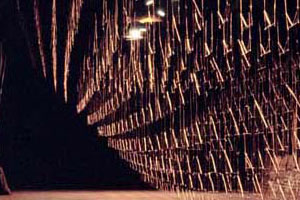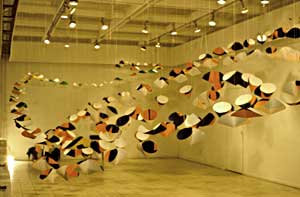Materials and construction methods relate to the history and functions of a locality. And many projects reconfigure materials already on site. Otherwise, I use recycled and found materials mindful of the environmental costs of making artworks.
ANIMAL, VEGETABLE, MINERAL, CULTURAL
Gateshead Riverside Park, 2021-2
The Riverside Routes project aimed to bring new life and audiences to The Riverside Park. Local schools and community groups explored the park alongside four artists and responded creatively to themes suggested by the many sculptures. The idea was to create small multiple artworks that could be included in activity packs designed for audiences new to the park.
These ready-folded origami modules can be opened and manipulated to reveal connections through time. Four historical map details open onto images of four of the riverside sculptures: Goat, Cone, Riverside Rivets, and James Hill Monument. By lifting the flaps, connections between sculpture and heritage are revealed. For example, gut works and glue factories (glues were made from horse, rabbit and fish) had existed on the site where the Goat sculptures are.
LOST & FOUND > DEWEY REMIX
Anglia Ruskin University Library, 2016
ArtSpace Gallery, Cambridge Artworks, 2016
Lost & Found is an artwork/map created for the Library of the Anglia Ruskin University. It is a ‘route map’ for journeying the Dewey System connecting the least with the most read books, as well as a flow chart: connecting text with campus. Whilst the ‘content’ is site specific, the ‘format’ would sit well in other settings where maps are found.
For “Mapping Translations” at ArtSpace Gallery, seven artists – with diverse backgrounds – came together to take up the curatorial challenge of relocating site-specific artworks to a 'white cube’ space. For this iteration I retained map-like features: the folds of a paper map and the Dewey number system, whilst incorporating new elements that responded to the work of the other artists.
NATURE OF CHANGE
National Trust for Scotland, Arran, 2013-2014
This residency was based on the unique natural history of Arran and
in particular: Sorbus arranensis - a Whitebeam/Rowan cross - native
to the island.
Please see Nature of Change blog | video
Intrigued by the changing leaf shape that is emerging as these trees evolve; my response has been to similarly transform leaves within a stand of Rhododendron magnificum on the NTS estate. I have cut some leaves - leaving others partially altered - thus highlighting the difference as well as showing how 'natural' the changed shape looks.
The making process has involved using only what is there - I have also taken nothing away - the artwork/intervention will change over a number of years as the cut leaves slowly ‘grow out’ and fall.
I hope my subtle interventions are an invitation to see our environment
afresh.
As part of the residency I invited writer Sara Maitland to join me,
she has written a short site-responsive story we hope to have published
soon. Visitors are invited to share their photos with us through a
flickr site www.flickr.com/groups/natureofchange
[K]NOT NET
Gairloch Heritage Museum, Scotland, 2013
During this residency I researched the impact of the scale change from domestic to industrial nets in the ‘local’ fishing industry. Please see blog: Pictish Fish.
A vision lodged in my head of a net so large and deep, strong and fine, that with one drag through water, it catches everything in its path. My response was to create a net that cannot catch, more void than material, and within it the negative space symbolic of the missing fish.
It is made entirely from rope found washed up on local beaches, their colours and shapes exquisite, but with every tide more and they neither degrade nor disappear without our intervention.
The museum is in the process of fundraising to move to a new location, the plan is to install [K]not Net in the new building (it is too large for the present one).
LEFT LUGGAGE
Oldenburg, Germany, 2011
A six week artist residency responding to the Station Quarter of Oldenburg.
The city was formerly the capital of the region and has pretensions to match, whereas the Station Quarter is an incoherent mix of Russian disco, insurance company headquarters, brothels and artists' studios.
The resulting installation/performance consisted of 30 metres of net curtain being 'taken for a walk'. The idea was to use a material belonging to the rest of the city on a tour of historically important sites that the city has come to ignore: the river, a water tower, the railway, and - as final destination - the original 'central station' which now resides within a huge expanse of wasteland.
Images courtesy of Iris Jousma & Thomas Kühn
TEMPORARY CONNECTION
Highgreen, Northumberland, 2010
For Visual Arts in Rural Communities 10th Birthday Celebrations, Karen collaborated with artist Helen Goodwin on a process based work in a field visible from Highgreen Manor.
Using materials found in that moorland landscape: sheep’s fleece and baling plastic, the artists worked in a site-responsive way, the process of moving through the landscape and mark-making with the materials taking priority over the creation of a finished product. The process was documented daily and the resulting photos displayed in the manor.
See more at Visual Arts in Rural Communities »
OASIS
Newcastle Building Society, Newcastle, 2008
Oasis is a suspended installation created specifically for the atrium
of the Society’s new building: Cobalt. The ideas and form for the
work were generated through discussions and making sessions with staff
whilst in residence over a three month period.
On each floor of the building are vending pods for soft drinks. As the
company have a strong recycling ethos it was decided to create the installation
entirely from over 350 plastic bottles sourced and recycled on site.
The building overlooks lakes where birds land and flock; through watching this process the idea was born to juxtapose artificial and natural. The bottles were cut to create bird-like forms, as if a strange translucent flock were frozen in mid ascent.
PRESENCE
St. Andrew's Cathedral, Inverness, 2008
Presence was the culmination of a three month residency on the theme of 'arts and spirituality' organised by 'the other side of air'.
Created from printed origami modules (designed by school children and community groups), the installation contained over 1,300 'inner messages' written by members of Inverness Riverside Churches congregations, their friends and families and the wider community.
Thoughtful interaction with the installation was encouraged: members of the public were able to open the origami flaps and read the messages.
THE LITTORAL ZONE
Flow, Donkleywood, Northumberland, 2007
Focussing on the microbiology of a pond, this collection of artworks formed part of the Exhibition: Flow, 4 ponds, 4 artists.
'The Littoral Zone' describes the area between shore and deep water where sunlight has access to the water bed and generates the greatest abundance and variety of life forms.
Water samples from the pond were analysed by students from Newcastle University. Using magnified images of micro-organisms from the samples, the artworks which constitute the Littoral Zone give visibility to elements of this ‘life soup’.
TRAVERSER
The Bridge, Tynemouth Metro Station, 2005.
Traversing the space, surfaces of ‘heat-mirror’ - a reflective
and flexible sheet PVC - were angled to catch light entering from south-facing
windows. Vibrations from the movement of trains and passengers set pools
of light in motion.
Using the linear/sequential quality of walkways and windows, the installation grew in stages. Lines which started as drips of a PVA/ink mix were - once dry - peeled up taking the reflective surface of the heat-mirror with them. Thus within these surfaces a negative transparent space recorded the progress of each dripped line
SALT
The Salt Museum, Cheshire, 2000-2002
Created to float on a brine pool, this installation utilised materials chosen for their links to the salt industry. The structure was inspired by salt crystals which form on the surface tension of brackish water if the salt concentration is high enough.
Fine detail was worked into the upper layers of the installation by a process of drawing with salt onto PVC; these drawings were created by workshop participants. All 144 designs were incorporated into the installation. This was a Year of the Artist funded residency.
LE STRANGE'S DREAM
The Green, Promenade & Beach, Hunstanton, 1998
This was inspired by the bright bold designs of the wind surfers' sails and kites around the resort; these fabrics withstand sun and rain well, so similar materials were used. Sun-umbrella frames became the mannequins for a series of 30 'sculptures'. Nine of the sculptures were designed and partially made by local school children.
The project was commissioned by the Borough Council of King's Lynn and W. Norfolk in partnership with Commissions East and Capital Challenge
RUMINANTS
A field, Wysing Arts, Cambridgeshire, 1997
The idea stemmed from walking ancient turf mazes in Lincolnshire combined with a love of spirals and helixes. The lie of the land, its history as a dairy farm and the more prosaic structure of a cow's stomach all helped to determine the shape.
Nothing was added to or removed from the field; the installation was created by cutting grass, and cutting and turning turf.
The work was commissioned by Wysing Arts as part of the show 'Seven Go Specific'.
DRAW IN, DRAW OUT
Ann Art Festival, Transylvania, Romania, 1997
The festival was sited in the crater of an extinct volcano. In the centre was a circular lake, above, a circle of sky framed by pines along the crater rim.
The performance took place beside the lake and involved slowly revolving within a seven metre span of heavy yellow canvas - worn as a skirt - so drawing the circle inwards and leaving the audience delineating the original 'low tide' line.
EAVES DROP
Blackthorpe Barn, Suffolk, 1996
This 100 foot long, 16th Century threshing barn has a steep roof of thatch; to reflect both this and the original use of the barn the installation was created in thatching straw.
The roof proportions were used in two/thirds scale to create this 20 metre long inversion of the roof interior.
The installation was commissioned by Blackthorpe Barn and formed part of the 1996 Bury St Edmunds Festival.
GIVE ME MORE!
Dorottya Gallery, Budapest, Hungary, 1992
Solo show sponsored by the Ministry of Culture & Public Education,
Hungary
The Gallery has a shop-window frontage and is located in Budapest's busiest shopping street. In 1992, bill-board hoardings were starting to appear in the city, so cut up bill-board paper was used to create the installation.
The aim was to create something enticing and wonderful that wasn't about buying, and where the joy was purely in beholding.

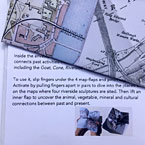
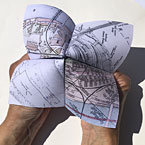
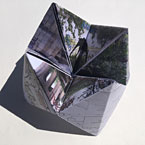
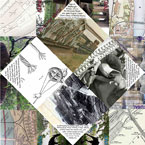
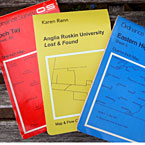
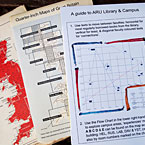
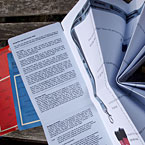
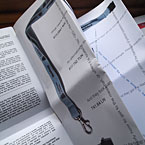
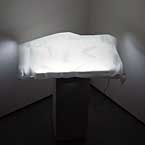
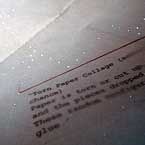
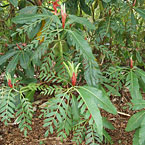
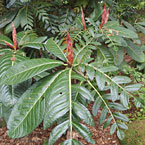
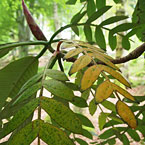
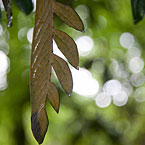
![Click to view larger image [K]not Net](../../pictures/largepics/2013-08/knot-montage-th.jpg)
![Click to view larger image [K]not Net](../../pictures/largepics/2013-08/knot-net-th.jpg)
![Click to view larger image [K]not Net](../../pictures/largepics/2013-08/knot-shadows-th.jpg)
![Click to view larger image [K]not Net](../../pictures/largepics/2013-08/knot-shadows-2-th.jpg)















